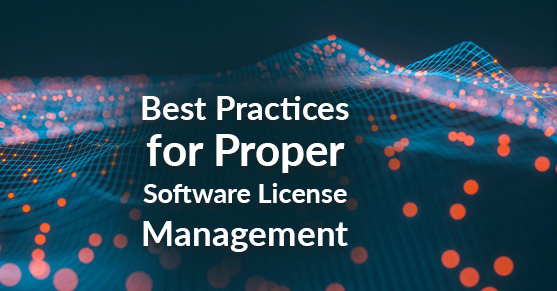Software license management is an essential part of any large or growing business, especially if your organization uses a variety of software and plans to accrue more in the future. Unfortunately, many companies struggle to maintain proper license management. Whether they find themselves confused about use rights or don’t have a strong understanding of the implications of virtualization, they fail to manage their software licenses properly.
However, by following a few best practices and aligning your team with a license management goal, you can avoid the repercussions of unmanaged software licenses.
Collect all Software Licenses and Documentation
Although this is the first step, it’s not the easiest. Procuring all the necessary licenses, documentation, and contracts can be a long, drawn-out process (especially if your company has been in business for more than a decade). However, as daunting as it might be, having all licensing information collected in a single repository is essential for maintaining proper licenses management. Not to mention it’ll save you time in the long run; when all of your software licenses and information is all in one central hub, it streamlines license assignment, delegation, and makes monitoring license usage much more straightforward.
Document/Review Internal License Processes and Assets
Once you have all the licenses and pertinent documentation in one place, your team needs to evaluate how your company implements/updates software. Each department of your organization requires multiple types of software for their daily activities, and amid digital transformation, that number continues to grow. Thus, every department needs to understand who authorizes software purchases, processes for recording licensing agreements, installation, and how the information is disseminated to the users.
In some cases, your organization may need to conduct a full audit of its licenses and licensing processes to maintain compliant licensing. Here are some questions you may want to ask yourself:
- Are all software installations accurately recorded and updated?
- Do you have an inventory of your software and overall usage in your organization? Is it accurate and up to date?
- Do you have policies to control the purchasing/distribution/use of software?
Answering “no” to any of these questions points to potential risks around your software licensing, and you may need to conduct a complete audit to attain compliance.
Achieve/Maintain License Compliance
License compliance is essential, and the sole responsibility of your organization — failing an audit could result in fees costing hundreds of thousands of dollars. To avoid those fees, it’s best to comply with the terms outlined in the software license. Here are some tips to gain compliance:
- Collect/record all license documents and entitlements for software usage in a secure location.
- Conduct an internal audit to ensure you have a thorough inventory of software, computers, users, and so on.
- Align your licenses to installed software and confirm the correct amount of users.
- If you find some discrepancy, address it immediately. For example, if you find that more users are on specific software than outlined in the license, reduce the number of users or procure a new license to match your needs.
Once you’ve gained compliance, begin planning and implementing strict procedures and policies to control software usage and manage licenses. Some ways of doing this include:
- Inform your directors, IT supervisors, and your entire staff on the importance of software license compliance. When your organization is on board with your compliance efforts, it’s easier to maintain procedures and catch red flags if they arise.
- Analyze IT policies, procedures, and documentation to ensure they promote quality software procurement and license management. Anytime something is updated, distribute them to the entire organization.
- Track costs and spending around software, and create reports to gain an understanding of expenditures and patterns that’ll affect your business in future software endeavors.
- Consistently readdress procurement and use practices to make sure they align with the terms in all licensing agreements.
Plan for the Future
The final step in license management is to plan for the future and make license management a crucial part of your business operations. Even if it’s not necessarily a part of their role at the company, each employee must have an understanding of software license management policies and procedures. Have your IT staff regularly review licenses and contracts, ensure your internal developers understand licensing options, costs, new applications, and other important updates to verify better decision making now and in the future.
Managing your software licenses doesn’t have to be a strenuous process or hindrance on your team; with the right strategy, it can be a walk in the park. For nearly a decade, XTIVIA has been helping companies manage their software licenses and maintain compliant licensing documentation. For more information, feel free to reach out to us here, or comment on this blog below.

